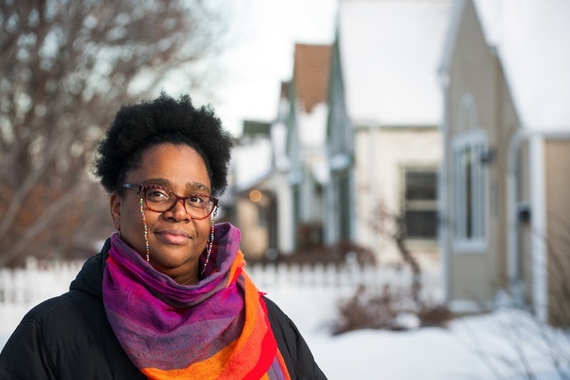Reclaiming Identity
Though her father is an enrolled member of the Minnesota Chippewa Tribe, alumna Nicole MartinRogers (BA ‘99, psychology and sociology; MPP ‘02; PhD ‘11, sociology) is unable to become a member.
“I'm not a tribal member, I don't get to vote in tribal elections, I'm not eligible for any tribal benefits, and also my kids and I are not eligible for a lot of other things like American Indian scholarships and other things where they require tribal citizenship,” she explains.
Her story is quite common among American Indian families as a result of blood quantum, a genocidal pseudoscience offered to tribal nations by the US government. Initially, blood quantum was framed as a way to define tribal citizenship, but no tribes had used this method before the federal government suggested it.
MartinRogers explains that children get half of the blood of their parent(s). “So for example,” she shares, “my dad is 23/64 and so I am 23/128 and my kids are 23/256, and our tribe requires 1/4 blood quantum to be enrolled.” Many tribes use 1/4 as their enrollment criteria, but fractions vary depending on the tribe. Also, MartinRogers notes that blood quantum can't be measured with a blood test or DNA test.
Now, as a result of blood quantum enrollment, some American Indian tribes are facing massive declines in membership over the next century. Without a change to blood quantum-based enrollment, many tribes could be heading for political and cultural extinction.
“They have to do something about this right now,” says MartinRogers, “because they’re not going to have a tribe in 100 years to worry about if they don't address this.”
Fortunately, there are those who are seeking a solution.
Conducting the Research
Through her position at Wilder Research, MartinRogers was contracted by the Red Lake Nation—spearheaded by Tribal Secretary Sam Strong—to conduct a study of what tribal membership numbers would look like based on a set of hypothetical changes to enrollment criteria.
The Tribe requested the projections to consider several different scenarios including allowing other Tribes' blood to count toward tribal members' blood quantum, reducing the blood quantum requirement to 1/8, or eliminating the blood quantum criteria entirely and instead using lineal descent. The population projects were completed using data from the Tribe’s enrollment records and a tribal member survey.
To assist with the projections, MartinRogers brought in Professor Carolyn Liebler (Sociology), a connection from her time in CLA. Together, they used the cohort component method, a standard method of projecting populations using five-year age groups. However, MartinRogers explains that they had to modify the method because they were projecting a population based on blood quantum, not geographic boundaries.
The process was also complicated by the US government’s lack of concern for data on American Indian people.
“There's a theme of invisibility,” says Liebler. “They are so often not included in studies, or they're in this “other” category. Even if you wanted to do research, the data is not available.”
Despite all of these hurdles, the researchers were able to complete the study and present the results to the Tribe. Now, it is up to Red Lake Nation leaders to determine what to do going forward.
Where the Tribe Goes from Here
Discussions about what to do with the research among the Tribe and its members are underway, which MartinRogers says is vital. MartinRogers and Secretary Strong held one virtual and three in-person listening sessions to share the results with tribal members and to start discussing next steps. They also produced a video, Red Lake Nation Enrollment Projections.
“It's interesting to hear also the things that people are worried about, like if we keep or change the enrollment criteria at ¼ blood quantum, what types of things people get concerned about, and I think that will be helpful for tribal leadership going forward,” MartinRogers explains. “Maybe we can move toward an arrangement that uses lineal descent as the enrollment criteria but also provides a lot of access to culture and language for tribal members. This would help make sure that the kids and new community members who are being enrolled in the tribe can learn the language and can learn the cultural practices so they know what that means to be a part of the community.”
Whatever decision the Tribe makes, it will be one they make for themselves. Liebler and the research team prioritized the collaborative nature of this project. Throughout this project, Liebler, MartinRogers, and Wilder Research have committed to honoring Tribal data sovereignty by only doing what the Tribe has asked them to do with their data. In fact, they received permission from Red Lake Nation prior to even agreeing to talk about their study for this article.
“It's community-engaged research because [Red Lake Nation] asked me for help, as opposed to me as an academic going to them and saying, ‘Could I use your data to move the field of demography forward?’” says Liebler. She describes the project—using data sovereignty to support tribal sovereignty—as an ideal collaboration between an alum, a faculty member, and community folks.
MartinRogers hopes that research like this will help tribes find a new way to define tribal citizenship that can change their population trajectory. Instead of extinction, the tribes can maintain and grow their membership, and hopefully begin to set their own destiny once again.
“None of this blood quantum stuff lines up with any actual scientific purpose. It was a tool of genocide that was imposed by the US government,” she explains. “Now, many tribes are trying to find a way to get out from under that trauma.”
Key Findings
- The Tribe's population will decline steeply over the next 100 years if they keep the enrollment criteria of 1/4 blood quantum, even if they allow other Tribes' blood to be counted toward tribal members' blood quantum.
- If the Tribe changes to 1/8 blood quantum, their population is likely to be maintained or even grow slightly over the next 100 years but will then start declining toward the end of that period.
- If the Tribe changes to lineal descent (meaning any direct descendant of someone who is on the Tribe's original enrollment record from the 1950s would be eligible to become a tribal member), their population would grow significantly over the next 100 years.
By Gannon Miller
This story was written by an undergraduate student in CLA.



